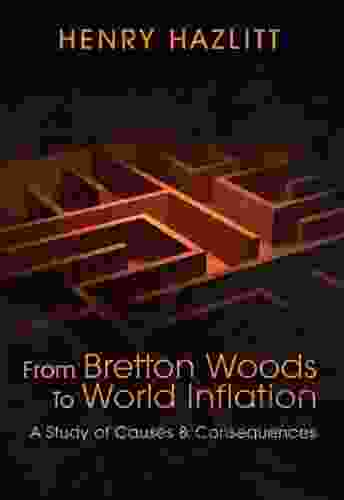Unraveling the Origins of Global Inflation: From Bretton Woods to the Modern Monetary Crisis

4.6 out of 5
| Language | : | English |
| File size | : | 475 KB |
| Text-to-Speech | : | Enabled |
| Screen Reader | : | Supported |
| Enhanced typesetting | : | Enabled |
| Word Wise | : | Enabled |
| Print length | : | 152 pages |
| Lending | : | Enabled |
In the wake of the devastating global economic turmoil of the Great Depression and World War II, the world's leading economic policymakers gathered at the historic Bretton Woods Conference in 1944. This pivotal event marked the birth of a new international monetary system, promising stability, growth, and prosperity after years of economic chaos.
The Bretton Woods system was based on a fixed exchange rate regime, with each country's currency pegged to the US dollar, which was in turn defined in terms of gold at a fixed rate of $35 per ounce. This arrangement was designed to prevent competitive currency devaluations and promote international trade and investment.
For over two decades, the Bretton Woods system delivered on its promises, presiding over a period of unprecedented global economic growth and stability. However, by the late 1960s, the system began to unravel under the weight of increasing economic pressures.
One of the key factors contributing to the demise of Bretton Woods was the growing trade deficit between the United States and its European and Asian trading partners.
As the US dollar became overvalued, it put downward pressure on the US balance of payments. To maintain the fixed exchange rate, the US was forced to intervene in currency markets by buying foreign currencies with dollars.
However, this intervention led to an unsustainable accumulation of dollars in the hands of foreign central banks, who began to worry about the stability of the US dollar and the gold-dollar peg.
In 1971, the US government was forced to abandon the gold-dollar peg and allow the dollar to float freely against other currencies. This marked the end of the Bretton Woods system and the beginning of a new era of floating exchange rates.
The collapse of Bretton Woods had a profound impact on the global economy. Without the discipline of fixed exchange rates, countries were free to pursue expansionary monetary policies, leading to a surge in global inflation.
This inflation was further exacerbated by the oil crises of the 1970s, which sent energy prices soaring and contributed to stagflation, a combination of high inflation and economic stagnation.
In the decades that followed, central banks around the world adopted a strategy of inflation targeting to control inflation. This strategy involves setting an inflation target and adjusting monetary policy to bring inflation back to the target.
While inflation targeting has been successful in bringing inflation down from the high levels of the 1970s, it has not been able to prevent inflation from creeping back up in recent years.
There are a number of factors that have contributed to the resurgence of inflation in recent years, including:
- The global financial crisis of 2008, which led to a surge in global debt and a decrease in interest rates
- The COVID-19 pandemic, which disrupted supply chains and led to a surge in government spending
- The war in Ukraine, which has sent energy and food prices soaring
These factors have combined to create a perfect storm for inflation, which is now at its highest level in decades. Central banks around the world are facing a difficult challenge in trying to bring inflation back under control without triggering a recession.
, the origins of global inflation can be traced back to the collapse of the Bretton Woods system in the early 1970s. Since then, inflation has been a persistent problem for the global economy, and it is only in recent years that it has begun to rear its ugly head once again.
The current inflationary surge is a reminder that the global economy is a complex system that is subject to a wide range of shocks. Central banks around the world will need to tread carefully as they try to bring inflation back under control.
4.6 out of 5
| Language | : | English |
| File size | : | 475 KB |
| Text-to-Speech | : | Enabled |
| Screen Reader | : | Supported |
| Enhanced typesetting | : | Enabled |
| Word Wise | : | Enabled |
| Print length | : | 152 pages |
| Lending | : | Enabled |
Do you want to contribute by writing guest posts on this blog?
Please contact us and send us a resume of previous articles that you have written.
 Book
Book Novel
Novel Page
Page Chapter
Chapter Text
Text Story
Story Genre
Genre Reader
Reader Library
Library Paperback
Paperback E-book
E-book Magazine
Magazine Newspaper
Newspaper Paragraph
Paragraph Sentence
Sentence Bookmark
Bookmark Shelf
Shelf Glossary
Glossary Bibliography
Bibliography Foreword
Foreword Preface
Preface Synopsis
Synopsis Annotation
Annotation Footnote
Footnote Manuscript
Manuscript Scroll
Scroll Codex
Codex Tome
Tome Bestseller
Bestseller Classics
Classics Library card
Library card Narrative
Narrative Biography
Biography Autobiography
Autobiography Memoir
Memoir Reference
Reference Encyclopedia
Encyclopedia Henry Harrison Brown
Henry Harrison Brown Ken Iverson
Ken Iverson Harlan Coben
Harlan Coben John Collins
John Collins Ronda Del Boccio
Ronda Del Boccio Kevin Elko
Kevin Elko Hope Comerford
Hope Comerford Sakthivel Pannerselvam
Sakthivel Pannerselvam Hawa Hassan
Hawa Hassan Heather Murdock
Heather Murdock Malinda Lo
Malinda Lo Horace Kephart
Horace Kephart Jeff Champion
Jeff Champion Heather Smith Thomas
Heather Smith Thomas Henci Goer
Henci Goer Harriet Denison
Harriet Denison Henry F Graff
Henry F Graff Thea Stilton
Thea Stilton Helen Sive Paxton
Helen Sive Paxton Jay Abramson
Jay Abramson
Light bulbAdvertise smarter! Our strategic ad space ensures maximum exposure. Reserve your spot today!

 Percy Bysshe ShelleyThe Practice and Science of Drawing by Harold Speed: Unlocking the Secrets of...
Percy Bysshe ShelleyThe Practice and Science of Drawing by Harold Speed: Unlocking the Secrets of... Blake KennedyFollow ·13.7k
Blake KennedyFollow ·13.7k Clarence BrooksFollow ·13k
Clarence BrooksFollow ·13k Henry Wadsworth LongfellowFollow ·10k
Henry Wadsworth LongfellowFollow ·10k Jerome BlairFollow ·2.6k
Jerome BlairFollow ·2.6k Elmer PowellFollow ·17k
Elmer PowellFollow ·17k Heath PowellFollow ·13.1k
Heath PowellFollow ·13.1k Alexander BlairFollow ·3.1k
Alexander BlairFollow ·3.1k Alfred RossFollow ·11.7k
Alfred RossFollow ·11.7k

 Fabian Mitchell
Fabian MitchellUnleash the Adventure: Family Fun in the Black Hills
Nestled amidst the rolling hills...

 Alfred Ross
Alfred RossUnleashing Peak Business Performance: A Journey of...
In today's rapidly evolving business...

 Fernando Bell
Fernando BellEmbrace the Prophetic Voice of Howard Zinn: A Journey...
As we navigate the complexities of our...

 Jonathan Franzen
Jonathan FranzenChildren of the Arctic: A Literary Expedition to the...
In the annals of...

 Branson Carter
Branson CarterYou Can Be Neutral on a Moving Train: A Transformative...
Welcome, dear reader,...
4.6 out of 5
| Language | : | English |
| File size | : | 475 KB |
| Text-to-Speech | : | Enabled |
| Screen Reader | : | Supported |
| Enhanced typesetting | : | Enabled |
| Word Wise | : | Enabled |
| Print length | : | 152 pages |
| Lending | : | Enabled |












